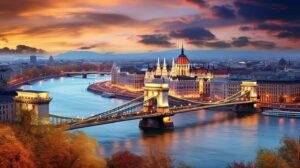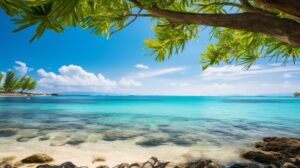The North Pole, the northernmost point on Earth, does not belong to any specific country. It is located in the middle of the Arctic Ocean, surrounded by high seas. This iconic location is where the Earth’s axis of rotation meets its surface, making it a significant point of interest.
Key Takeaways:
- The North Pole is not in any specific country and is situated in the Arctic Ocean.
- It is the northernmost point on Earth, where the Earth’s axis of rotation intersects its surface.
- The nearest land to the North Pole is Kaffeklubben Island, off the northern coast of Greenland.
- The North Pole is distinct from the Magnetic North Pole, which is determined by the Earth’s magnetic field.
- The Arctic region, including the North Pole, is subject to territorial disputes involving the United States, Canada, Russia, Norway, and Denmark.
Geographical Location of the North Pole
The North Pole is located in the middle of the Arctic Ocean, surrounded by high seas. It is the northernmost point on Earth, where the Earth’s axis of rotation meets its surface. Situated at approximately 90 degrees north latitude, the North Pole is at the heart of the Arctic region.
The Arctic region, known for its extreme cold temperatures and unique climate, encompasses the North Pole. This area is subject to ongoing territorial disputes between several countries, including the United States, Canada, Russia, Norway, and Denmark. These disputes arise due to the region’s strategic importance, rich natural resources, and potential for new shipping routes as sea ice melts.
Nearest Land to the North Pole
While the North Pole itself is surrounded by open ocean, the nearest land is often identified as Kaffeklubben Island. This small island is situated off the northern coast of Greenland and is approximately 700 kilometers (435 miles) away from the North Pole. Despite its remote and barren nature, Kaffeklubben Island serves as a significant point of reference for understanding the proximity of land to the North Pole.
The distinction between the Geographic North Pole and the Magnetic North Pole should also be noted. The Magnetic North Pole, which is the point where the Earth’s magnetic field points directly downwards, is not located at the same spot as the Geographic North Pole. These two poles have different coordinates and serve different scientific purposes.
In summary, the North Pole is a unique and important location in the Arctic region. It is surrounded by high seas in the middle of the Arctic Ocean and has no specific country ownership. The nearest land, Kaffeklubben Island, is situated off the northern coast of Greenland. The North Pole’s geographical location and its distinction from the Magnetic North Pole make it a subject of scientific study and territorial disputes among nations.
| Key Points: |
|---|
| – The North Pole is located in the middle of the Arctic Ocean, surrounded by high seas. |
| – The Arctic region, including the North Pole, is subject to territorial disputes. |
| – Kaffeklubben Island is the nearest land to the North Pole, located off the northern coast of Greenland. |
| – The Magnetic North Pole and the Geographic North Pole are separate entities. |
Nearest Land to the North Pole
The nearest land to the North Pole is typically identified as Kaffeklubben Island, which is located off the northern coast of Greenland. Situated at approximately 83.6°N latitude, this small uninhabited island is known for its association with the North Pole and its extreme climate.
Kaffeklubben Island, sometimes referred to as Coffee Club Island, is only about 30 meters above sea level and measures approximately 1.4 square kilometers in area. Despite its small size, it holds the distinction of being the northernmost island in the world.
The island’s name, which translates to “coffee club,” is said to have originated from a Danish expedition that explored the region in the early 20th century. Today, Kaffeklubben Island serves as a significant landmark in the Arctic region and is a testament to the harsh conditions that can be found near the North Pole.
Although Kaffeklubben Island is the closest landmass to the North Pole, it is still over 700 kilometers away. As the ice-covered Arctic Ocean stretches out from the island, it is a reminder of the vast expanse of the high seas that surround the North Pole, which is located in international waters without any specific territorial claims.
| Kaffeklubben Island Facts | |
|---|---|
| Location | Off the northern coast of Greenland |
| Latitude | Approximately 83.6°N |
| Size | Approximately 1.4 square kilometers |
| Altitude | About 30 meters above sea level |
Distinction from Magnetic North Pole
It is important to note the distinction between the Geographic North Pole and the Magnetic North Pole. While the Geographic North Pole refers to the northernmost point on Earth, where the Earth’s axis of rotation meets its surface, the Magnetic North Pole is the point where the Earth’s magnetic field points directly downwards. This distinction is crucial in understanding the different aspects and significance of these two poles.
The Geographic North Pole, located in the middle of the Arctic Ocean, does not belong to any specific country as it is surrounded by high seas. It serves as a reference point for navigational purposes and is a symbol of the Earth’s extreme northern latitude. The nearest land to the North Pole is often identified as Kaffeklubben Island, situated off the northern coast of Greenland. While the Arctic region, which includes the North Pole, is a subject of territorial disputes between countries such as the United States, Canada, Russia, Norway, and Denmark, the North Pole itself remains neutral territory.
On the other hand, the Magnetic North Pole is constantly moving due to changes in the Earth’s magnetic field. It is currently located in the Canadian Arctic, but its position is not fixed. The Magnetic North Pole plays a crucial role in navigation, as it influences the compass readings and provides guidance for sailors and explorers. Understanding the difference between these two poles allows for a deeper appreciation of the complex nature of our planet’s magnetic and geographic characteristics.
| Geographic North Pole | Magnetic North Pole |
|---|---|
| Located in the middle of the Arctic Ocean | Currently situated in the Canadian Arctic |
| Does not belong to any specific country | Subject to the sovereignty of neighboring countries |
| Serves as a navigational reference point | Influences compass readings |
| Neutral territory | Moves due to changes in the Earth’s magnetic field |
Territorial Disputes in the Arctic Region
The Arctic region, encompassing the North Pole, is a subject of territorial dispute among several countries, including the United States, Canada, Russia, Norway, and Denmark. These nations have competing claims over the vast expanse of the Arctic, which is believed to hold significant reserves of oil, gas, and other valuable resources.
In recent years, the melting of Arctic ice due to global warming has opened up new opportunities for exploration and economic activities in the region. Each country is vying for control and access to these resources, leading to tensions and disagreements.
Canada and Denmark both lay claim to certain Arctic territories, with Canada asserting that the North Pole lies within its exclusive economic zone. Russia, on the other hand, has been actively expanding its presence in the region, conducting military exercises and establishing new military bases. The United States and Norway also have strategic interests in the Arctic and are closely monitoring the developments.
Despite the ongoing territorial disputes, there have been efforts to establish diplomatic dialogue and negotiate agreements among the countries involved. The United Nations Convention on the Law of the Sea (UNCLOS) provides a framework for resolving such disputes, but reaching a consensus remains challenging.
| Country | Territorial Claim |
|---|---|
| United States | Alaska |
| Canada | Northwest Passage |
| Russia | Arctic Ocean shelf |
| Norway | Svalbard and Jan Mayen |
| Denmark | Greenland |
Conclusion
The territorial disputes in the Arctic region, particularly around the North Pole, remain complex and unresolved. The competing claims and interests of the United States, Canada, Russia, Norway, and Denmark have created geopolitical tensions in the region. As global warming continues to reshape the Arctic landscape, the importance of establishing clear boundaries and cooperative agreements becomes even more crucial.
Climate and Environment at the North Pole
The North Pole experiences extreme cold temperatures and has a unique climate due to the Earth’s tilted axis. Situated in the middle of the Arctic Ocean, the North Pole is characterized by long, harsh winters with average temperatures dropping to -40 degrees Celsius (-40 degrees Fahrenheit). Summers are short and cool, with temperatures rarely rising above freezing.
The North Pole’s climate is heavily influenced by its proximity to the polar ice cap, which covers the region for most of the year. The vast expanse of Arctic ice reflects sunlight back into space, contributing to the overall cooling effect. However, the delicate Arctic ecosystem is under threat from global warming, which is causing the melting of Arctic ice at an alarming rate.
The melting of Arctic ice poses significant challenges to the North Pole. As the ice continues to melt, it not only affects the unique wildlife and plant species that rely on it for survival but also contributes to rising sea levels. The increased release of freshwater from melting ice into the ocean disrupts the delicate balance of salinity and can have far-reaching consequences for global ocean currents and weather patterns.
| Impact of Global Warming on the North Pole | Consequences |
|---|---|
| Melting of Arctic Ice | – Endangered Arctic wildlife and plants |
| Rising Sea Levels | – Increased risk of coastal flooding |
| Disrupted Ocean Currents | – Altered weather patterns |
Preserving the delicate balance of the North Pole’s climate and environment is crucial for the overall health of the planet. Efforts to mitigate global warming and reduce greenhouse gas emissions are essential to protect this unique and vital region.
North Pole vs. Santa’s Workshop
Contrary to popular belief, Santa’s workshop is not situated at the Geographic North Pole. However, there are places that fully embrace the Christmas spirit and pay homage to Santa’s workshop. Two such locations are North Pole, New York and North Pole, Alaska.
In North Pole, New York, visitors can experience the magic of the holiday season all year round. The town is adorned with festive decorations and offers various attractions, including Santa’s workshop, where children can meet Santa Claus himself. It’s a place where Christmas cheer is celebrated every day.
Similarly, North Pole, Alaska also embraces the Christmas theme. Every year, the town hosts the North Pole Christmas in Ice Festival, featuring ice sculpture contests, light displays, and visits from Santa Claus. It’s a destination that captures the essence of the holiday season and brings joy to both locals and visitors.
While Santa’s workshop may not be located at the Geographic North Pole, these towns in New York and Alaska keep the magic alive, allowing people to experience the joy and wonder of Christmas throughout the year.
| Location | Features |
|---|---|
| North Pole, New York | Santa’s workshop, Christmas decorations, festive atmosphere |
| North Pole, Alaska | Christmas in Ice Festival, ice sculptures, light displays, visits from Santa Claus |
Conclusion and Final Thoughts
In conclusion, the North Pole is a fascinating realm situated in the Arctic Ocean, free from any specific country’s jurisdiction and subject to ongoing territorial disputes. Located in the middle of the Arctic Ocean, it is the northernmost point on Earth, where the Earth’s axis of rotation meets its surface. While the North Pole itself does not belong to any particular country, the nearest land is often identified as Kaffeklubben Island, off the northern coast of Greenland.
The North Pole is distinct from the Magnetic North Pole, which is the point where the Earth’s magnetic field points directly downwards. The Arctic region, which encompasses the North Pole, is a subject of territorial disputes among countries such as the United States, Canada, Russia, Norway, and Denmark. These disputes arise from the potential resources and strategic importance of the region.
The North Pole experiences extreme cold temperatures and has a unique climate due to the Earth’s tilted axis. The melting of Arctic ice, caused by global warming, poses a significant threat to the North Pole’s ecosystem and contributes to rising sea levels. This has implications not only for the region’s delicate balance of biodiversity but also for the rest of the world.
It’s important to note that Santa’s workshop is not located at the Geographic North Pole. However, there are places like North Pole, New York, and North Pole, Alaska that embrace the Christmas theme and add a touch of magic to the holiday season. These locations have become popular destinations for those seeking a festive experience.
In summary, the North Pole is a captivating place with its remote location in the Arctic Ocean and its significance as a meeting point between the Earth’s axis and its surface. As an area of ongoing territorial disputes and with its unique climate and environmental challenges, the North Pole remains a focal point for research, conservation efforts, and global discussions on climate change.
FAQ
Q: What country is the North Pole in?
A: The North Pole does not belong to any specific country as it is located in the middle of the Arctic Ocean, surrounded by high seas.
Q: What is the geographical location of the North Pole?
A: The North Pole is the northernmost point on Earth, where the Earth’s axis of rotation meets its surface. It is located in the Arctic region.
Q: What is the nearest land to the North Pole?
A: The nearest land to the North Pole is usually said to be Kaffeklubben Island, off the northern coast of Greenland.
Q: What is the distinction between the Geographic North Pole and the Magnetic North Pole?
A: The Geographic North Pole is the point where the Earth’s axis of rotation meets its surface, while the Magnetic North Pole is the point where the Earth’s magnetic field points directly downwards.
Q: Are there any territorial disputes in the Arctic region, including the North Pole?
A: Yes, the Arctic region, which includes the North Pole, is a subject of territorial dispute between the United States, Canada, Russia, Norway, and Denmark.
Q: What is the climate and environment like at the North Pole?
A: The North Pole experiences extreme cold temperatures and has a unique climate due to the Earth’s tilted axis. The melting of Arctic ice due to global warming is a concern for the North Pole’s ecosystem and rising sea levels.
Q: Is Santa’s workshop located at the North Pole?
A: No, Santa’s workshop is not located at the Geographic North Pole. However, there are places like North Pole, New York, and North Pole, Alaska that embrace the Christmas theme.
Q: What are the key facts about the North Pole?
A: The North Pole is located in the Arctic Ocean, is the northernmost point on Earth, and is surrounded by high seas. It is distinct from the Magnetic North Pole and is subject to territorial disputes. The North Pole experiences extreme cold temperatures and has a unique climate. Santa’s workshop is not located at the Geographic North Pole, but there are places that embrace the Christmas theme.



